อิทธิพลของภาวะผู้นำแบบให้บริการของหัวหน้าหอผู้ป่วยต่อบรรยากาศองค์การตามการรับรู้ของ พยาบาลวิชาชีพ โรงพยาบาลทั่วไป เขตสุขภาพที่ 1
Main Article Content
บทคัดย่อ
การวิจัยเชิงพรรณนาครั้งนี้มีวัตถุประสงค์เพื่อศึกษา 1) ระดับภาวะผู้นำแบบให้บริการของหัวหน้า หอผู้ป่วย ตามการรับรู้ของพยาบาลวิชาชีพในโรงพยาบาลทั่วไป เขตสุขภาพที่1 2) ระดับบรรยากาศองค์การ ตามการรับรู้ของพยาบาลวิชาชีพในโรงพยาบาลทั่วไป เขตสุขภาพที่ 1 3)อิทธิพลของภาวะผู้นำแบบให้ บริการของหัวหน้าหอผู้ป่วยต่อบรรยากาศองค์การ ตามการรับรู้ของพยาบาลวิชาชีพในโรงพยาบาลทั่วไป เขตสุขภาพที่ 1 กลุ่มตัวอย่างเป็นพยาบาลวิชาชีพซึ่งปฏิบัติงานให้บริการกับผู้ใช้บริการในโรงพยาบาลทั่วไป เขตสุขภาพ ที่ 1 จำนวน 335 คน เครื่องมือที่ใช้เป็นแบบสอบถาม ประกอบไปด้วยแบบสอบถามข้อมูลทั่วไป ระดับ ภาวะผู้นำแบบให้บริการของหัวหน้าหอผู้ป่วย ในโรงพยาบาลทั่วไปเขตสุขภาพที่ 1 และระดับบรรยากาศ องค์การ ของพยาบาลวิชาชีพ ในโรงพยาบาลทั่วไปเขตสุขภาพที่ 1 ตรวจสอบความตรงโดยใช้วิธีดัชนี ความสอดคล้องระหว่างขอคำถามกับตัวแปร ประเด็นและมิติของตัวแปรการวิจัย IOC (Indexofconcurrence) มีค่าระหว่าง 0. 80 - 1.00 และความเที่ยงของแบบสอบถามโดยหาค่าสัมประสิทธิ์แอลฟาของครอนบาคของ แบบสอบถามแต่ละส่วนเท่ากับ 0.99 และ 0.96 ตามลำดับ วิเคราะห์ข้อมูลโดยใช้โปรแกรมสำเร็จรูปหาค่า ร้อยละค่าเฉลี่ย ค่าเบี่ยงเบนมาตรฐาน ค่าสัมประสิทธิ์สหสัมพันธ์ของเพียร์สัน(Pearson's Product Moment Correlation Coefficient) และวิเคราะห์สมการถดถอยพหุคูณแบบขั้นตอน (Stepwise Multiple Regression Analysis) ผลการวิจัยพบว่า 1) ระดับภาวะผู้นำแบบให้บริการของหัวหน้าหอผู้ป่วย ในโรงพยาบาลทั่วไป เขตสุขภาพที่ 1 โดยรวมอยูใ่ นระดับสูง ( x = 3.81, SD = .64) 2) ระดับบรรยากาศองคก์ ารของพยาบาลวิชาชีพในโรงพยาบาลทั่วไปเขตสุขภาพที่ 1 โดยรวมอยู่ในระดับสูง ( = 3.81, SD = .64) 3) ภาวะผู้นำแบบ ให้บริการของหัวหน้าหอผู้ป่วย มีอิทธิพลต่อบรรยากาศองค์การ ของพยาบาลวิชาชีพ ในโรงพยาบาลทั่วไป เขตสุขภาพที่ 1อย่างมีนัยสำคัญทางสถิติที่ระดับ .01คือ ด้านการดูแลบริการ ด้านการสร้างชุมชน ด้านการ มองการณ์ไกล ด้านการโน้มน้าวใจ และด้านการตระหนักรู้ โดยสามารถร่วมกันพยากรณ์บรรยากาศองค์การ ตามการรับรู้ของพยาบาลวิชาชีพในโรงพยาบาลทั่วไปเขตสุขภาพที่ 1 ได้ร้อยละ 55.3 (R2 = .553)
Article Details
เอกสารอ้างอิง
ยุทธศาสตร์กลุ่มการการพยาบาล โรงพยาบาลแพร่
ปีงบประมาณ 2558-2560.โรงพยาบาลแพร่.
กลุ่มการพยาบาล โรงพยาบาลแพร่.(2559).รายงาน
ประจำปีกลุ่มการพยาบาล (ปีงบประมาณ
2556 - 2558).โรงพยาบาลแพร่.
กฤษดา แสวงดี. (2551).สถานการณ์กำลังคนพยาบาล
วิชาชีพ ในประเทศไทย. วารสารวิจัยระบบ
สุขภาพ, 2(2), 40-46.
กฤษดา แสวงดี. (2555).ข้อเสนอนโยบายความ
ขาดแคลนพยาบาล. วารสารสภาการพยาบาล,
27(1), 5-12
จินดารัตน์ โรมา.(2543). ความสัมพันธ์ระหว่างปัจจัย
ส่วนบุคคล การเสริมสร้างพลังอำนาจ ในงานและ
บรรยากาศองค์การ กับภาวะผู้นำของพยาบาล
วิชาชีพ โรงพยาบาลศูนย์ เขตภาคกลาง สังกัด
กระทรวงสาธารณสุข. วิทยานิพนธ์ มหาบัณฑิต.
วิทยาศาสตร์ (พยาบาลสาธารณสุข) บัณฑิต
วิทยาลัยมหาวิทยาลัยมหิดล.
โฉมฤทัย ทองนุช. (2556).ความสัมพันธ์ระหว่างการ
รับรู้บรรยากาศองค์การความเครียดในการ
ปฏิบัติงานและคุณภาพชีวิตในการทำงานของ
พยาบาลวิชาชีพ : กรณีศึกษาโรงพยาบาลในเขต
จังหวัดปทุมธานี.วิทยานิพนธ์บริหารธุรกิจ
มหาบัณทิต สาขาวิชาการจัดการทั่วไป,
มหาวิทยาลัยเทคโนโลยีราชมงคลธัญญบุรี,
ปทุมธานี.
ณัฎชารี กัณทะเกตุ (2558).ความสัมพันธ์ระหว่างภาวะ
ผู้นำบารมีของหัวหน้าหอผู้ป่วยกับบรรยากาศ
องค์กรตามการรับรู้ของพยาบาลวิชาชีพ
โรงพยาบาลตติยภูมิ. วิทยานิพนธ์พยาบาลศาสตร
มหาบัณทิต. สาขาวิชาการบริหารการพยาบาล,
บัณฑิตวิทยาลัย มหาวิทยาลัยนเรศวร, พิษณุโลก.
ประสพ อินสุวรรณ (2557).บรรยากาศองค์การกับคุณภาพ
ชีวิตการทำงานของพยาบาลวิชาชีพ กลุ่มการ
พยาบาล โรงพยาบาลศรีรัตนะ จังหวัดศรีสะเกษ.
วารสารวิทยาลัยบรมราชชนนีนครราชสีมา.
20(1), 55-66.
รุ่งนภา เปล่งอารมณ์ (2555).ความสัมพันธ์ระหว่าง
บรรยากาศองค์การกับสมรรถนะพยาบาล
ห้องผ่าตัดโรงพยาบาลระดับตติยภูมิในจังหวัด
สุพรรณบุรี. วิทยานิพนธ์พยาบาลศาสตร
มหาบัณทิต. สาขาวิชาการบริหารการพยาบาล,
บัณฑิตวิทยาลัย มหาวิทยาลัยคริสเตียน, กรุงเทพ
มหานคร..
วรีรัตน์ เฉลิมทอง. (2559). ความสัมพันธ์ระหว่าง
ภาวะผู้นำใฝ่บริการของหัวหน้าหอผู้ป่วยตาม
การรับรู้ของพยาบาลวิชาชีพกับแรงจูงใจของ
พยาบาลวิชาชีพโรงพยาบาลมหาวิทยาลัย
ภาคเหนือตอนล่าง.วิทยานิพนธ์พยาบาลศาสตร
มหาบัณทิต. สาขาวิชาการบริหารการพยาบาล,
บัณฑิตวิทยาลัย มหาวิทยาลัยนเรศวร, พิษณุโลก.
สำนักนโยบายและยุทธศาสตร์ กระทรวงสาธารณสุข.
(2556). รายงานประจำปี 2556
สำนักนโยบายและยุทธศาสตร์ กระทรวงสาธารณสุข.
กรุงเทพฯ
สัมฤทธิ์ กางเพ็งและสรายุทธ กันหลง. (2553).
ภาวะผู้นำแบบบริการในองค์การ: แนวคิด
หลักการทฤษฎีและงานวิจัย.พิมพ์ครั้งที่ 2.
ขอนแก่น: คลังนานาวิทยา.
อัครินทร์ ภักดี.(2558).ความสัมพันธ์ระหว่างภาวะ
ผู้นำแบบใฝ่บริการกับประสิทธิผลของหอผู้ป่วย
โรงพยาบาลมหาวิทยาลัยนเรศวร.วารสาร
การพยาบาลและสุขภาพ.9(3), 78-85
Brown.W. &Moberg.D. (1980). Organizational theory
and management : A macro Approach.Journal
of Management Study. 18: 420
Black, Glenda Lee. (2010).A correlational analysis of
servant leadership and school climate.Ed.D.
dissertation, University of Phoenix, United
States -- Arizona. Retrieved January 31, 2009,
from Dissertations & Theses: A&I database.
(Publication No.AAT 3309254).
Dubrin, A.J. (1984). Foundations of Organizational
Behavior. USA: Prentice-Hall, Inc.
Greenleaf, R. K. (1970). The servant as leader. Newton
Center, MA: Robert K. Greenleaf Center.
Marquis, B.L.&Huston, C. J. (2009). Leadership Roles
and Management functions in Nursing theory
and Application (6thed.).China: Wolters Kluwer
Health /Lippincott Williams& Wilkins
Slocum, J. W. (1974). Organizational climate:
Measures, research and contingencies.
Academy of Management Journal, 17, 255-280.
Retrived June, 22, 2015, from http://journals.
sagepub.com/doi/abs/10.1177/21582440155
82229


